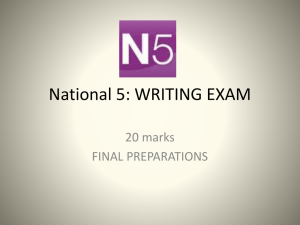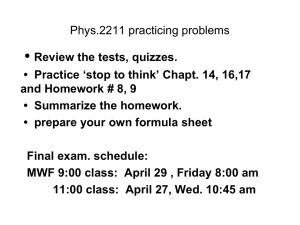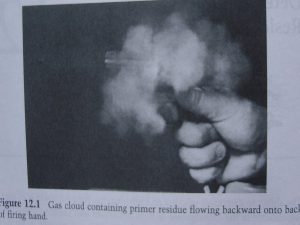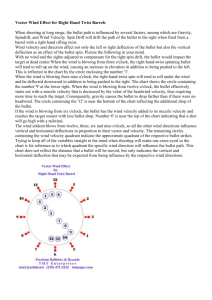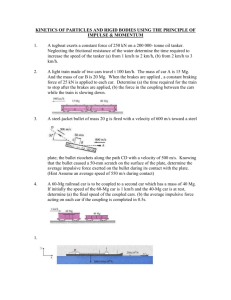File
advertisement
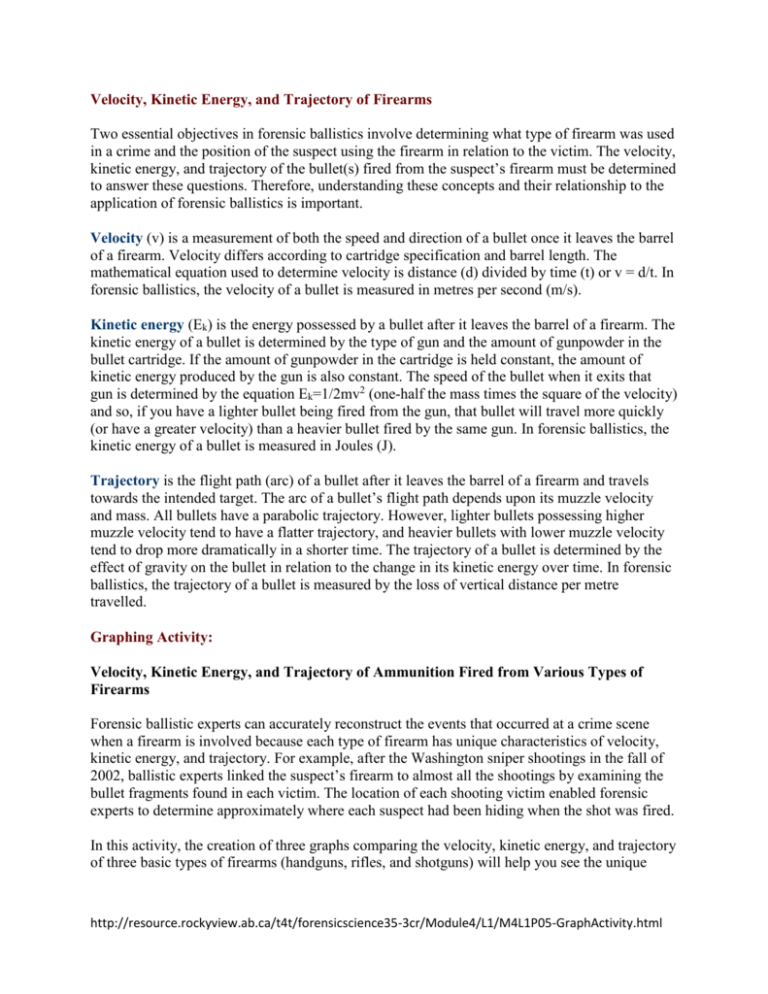
Velocity, Kinetic Energy, and Trajectory of Firearms Two essential objectives in forensic ballistics involve determining what type of firearm was used in a crime and the position of the suspect using the firearm in relation to the victim. The velocity, kinetic energy, and trajectory of the bullet(s) fired from the suspect’s firearm must be determined to answer these questions. Therefore, understanding these concepts and their relationship to the application of forensic ballistics is important. Velocity (v) is a measurement of both the speed and direction of a bullet once it leaves the barrel of a firearm. Velocity differs according to cartridge specification and barrel length. The mathematical equation used to determine velocity is distance (d) divided by time (t) or v = d/t. In forensic ballistics, the velocity of a bullet is measured in metres per second (m/s). Kinetic energy (Ek) is the energy possessed by a bullet after it leaves the barrel of a firearm. The kinetic energy of a bullet is determined by the type of gun and the amount of gunpowder in the bullet cartridge. If the amount of gunpowder in the cartridge is held constant, the amount of kinetic energy produced by the gun is also constant. The speed of the bullet when it exits that gun is determined by the equation Ek=1/2mv2 (one-half the mass times the square of the velocity) and so, if you have a lighter bullet being fired from the gun, that bullet will travel more quickly (or have a greater velocity) than a heavier bullet fired by the same gun. In forensic ballistics, the kinetic energy of a bullet is measured in Joules (J). Trajectory is the flight path (arc) of a bullet after it leaves the barrel of a firearm and travels towards the intended target. The arc of a bullet’s flight path depends upon its muzzle velocity and mass. All bullets have a parabolic trajectory. However, lighter bullets possessing higher muzzle velocity tend to have a flatter trajectory, and heavier bullets with lower muzzle velocity tend to drop more dramatically in a shorter time. The trajectory of a bullet is determined by the effect of gravity on the bullet in relation to the change in its kinetic energy over time. In forensic ballistics, the trajectory of a bullet is measured by the loss of vertical distance per metre travelled. Graphing Activity: Velocity, Kinetic Energy, and Trajectory of Ammunition Fired from Various Types of Firearms Forensic ballistic experts can accurately reconstruct the events that occurred at a crime scene when a firearm is involved because each type of firearm has unique characteristics of velocity, kinetic energy, and trajectory. For example, after the Washington sniper shootings in the fall of 2002, ballistic experts linked the suspect’s firearm to almost all the shootings by examining the bullet fragments found in each victim. The location of each shooting victim enabled forensic experts to determine approximately where each suspect had been hiding when the shot was fired. In this activity, the creation of three graphs comparing the velocity, kinetic energy, and trajectory of three basic types of firearms (handguns, rifles, and shotguns) will help you see the unique http://resource.rockyview.ab.ca/t4t/forensicscience35-3cr/Module4/L1/M4L1P05-GraphActivity.html ballistic properties exhibited by each. After you have completed each graph, answer the related questions. Graph #1: Comparison of the VELOCITY of Ammunition Fired from Various Firearms Problem: How do the average velocities of handgun, rifle, and shotgun rounds differ? Procedure: Use the data below to plot three lines on one graph. Use the x-axis to represent the three distances: 0 m (muzzle), 50 m, and 100 m. Use the y-axis to represent bullet velocity (in metres/second). Provide a legend for your graph; a title is given. VELOCITY (metre/second) at a distance of Type of Firearm Type of Ammunition Type of Bullet 0m (muzzle) 50m 100m Pistol 9 mm Luger Jacketed hollow point 352 329 296 Rifle .223 Remington Metal jacket 988 930 841 Shotgun 12-gauge Slug 3inch/ 1oz. slug 536 454 328 Related Questions: Velocity of Ammunition Fired from Various Firearms 1. Which type of firearm shoots bullets with the highest initial velocity? 2. What happens to the velocity of each type of bullet as it moves away from where it was shot? 3. Which type of ammunition loses speed at the quickest rate? http://resource.rockyview.ab.ca/t4t/forensicscience35-3cr/Module4/L1/M4L1P05-GraphActivity.html Graph #2: Comparison of the KINETIC ENERGY of Ammunition Fired from Various Firearms Problem: How do the kinetic energy levels of a handgun, a rifle, and a shotgun differ? Procedure: Use the data below to plot three lines on one graph. Use the x-axis to represent the three distances: 0 m (muzzle), 50 m, and 100 m. Use the y-axis to represent kinetic energy (in Joules). Provide a legend for your graph; a title is given. KINETIC ENERGY (Joules) at a distance of Type of Firearm Type of Ammunition Type of Bullet 0m (muzzle) 50m 100m Pistol 9 mm Luger Jacketed hollow point 462 380 327 Rifle .223 Remington Metal jacket 1738 1410 1260 Shotgun 12-gauge Slug 3inch/ 1oz. slug 4070 2380 1520 Related Questions: Kinetic Energy of Ammunition Fired from Various Firearms 1. Which firearm projects its bullet with the most kinetic energy? Explain. 2. Why does the kinetic energy of each bullet decline as it moves away from where it was shot? 3. Which type of ammunition loses kinetic energy at the slowest rate? http://resource.rockyview.ab.ca/t4t/forensicscience35-3cr/Module4/L1/M4L1P05-GraphActivity.html Graph #3: Comparison of the TRAJECTORY of Ammunition Fired from Various Firearms Problem: How does the trajectory of a projectile differ when fired by a handgun, a rifle, or a shotgun? Procedure: Use the data below to plot three lines on one graph. Use the x-axis to represent the three distances: 0 m (muzzle), 50 m, and 100 m. Use the y-axis to represent change in height in centimetres. Provide a legend for your graph; a title is given. CHANGE IN HEIGHT (centimetres) Distance from Firearm(m) Type of Firearm Type of Ammunition Type of Bullet 0m (muzzle) 50m 100m 200m Pistol 9 mm Luger Jacketed hollow point -2.1 -7.9 -14.5 -21.9 Rifle .223 Remington Metal jacket -2.9 -4.8 -7.2 -14.0 Shotgun 12-gauge Slug 3inch/ 1oz. slug -3.8 -9.4 -18.9 -31.8 Related Questions: Trajectory of Ammunition Fired from Various Firearms 1. Explain which type of firearm ammunition is the most accurate at hitting its target at short range (50 m). 2. Explain which type of firearm ammunition is the most accurate at hitting its target at longer ranges. http://resource.rockyview.ab.ca/t4t/forensicscience35-3cr/Module4/L1/M4L1P05-GraphActivity.html


